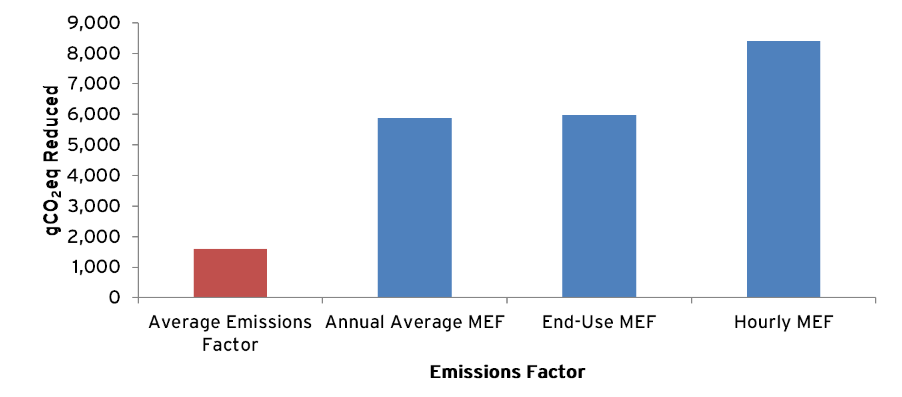(Editor’s note: TAF updated its electricity emissions guide in 2019.)
In some ways, carbon emissions are like money. You need to know what you are ‘spending’ to know where you have the potential for savings. That’s why the ability to accurately quantify carbon emissions is so fundamental to planning climate actions – whether it’s a government program or conserving electricity at home.
Electricity consumption constituted 3.7 per cent of Ontario’s carbon emissions in 2015. While emissions from overall power generation are relatively easy to quantify, things get tricky if you want to quantify conservation measures. In Ontario, around 90 per cent of electricity is produced carbon-free (hydro, nuclear, renewables), but the remainder comes from natural gas – especially during peak hours. As the carbon emissions of electricity generation fluctuate, so does the impact of conserving or shifting energy consumption.
To accurately quantify the carbon intensity of a specific end-use or conservation measures, we need emissions factors (expressed in grams of CO2eq per kWh) that account for which sources of generation would have not been turned on if demand was reduced.
Conventional methods use averages to give uniform emissions/kWh (known as an Average Emissions Factor). However, this method falls short when looking at the emissions associated with a particular end-use at a specific time.
New TAF research shows how emissions vary hour-by-hour
To fill the gap and help with the quantification of electricity-related emissions in Ontario, TAF has developed a new set of emissions factors and published them in a handy guide. Analyzing 2016 data from the Independent Electricity System Operator (IESO), the new emissions factors better represent the potential impacts of reducing or shifting the consumption of grid electricity.
For the first time, TAF’s emissions factors reflect the variation in Ontario’s energy generation throughout the day as Marginal Emission Factors (MEFs). This approach will help stakeholders better assess and quantify emissions reductions measures.
Let’s take a look at how to apply TAF practitioner’s guide to Marginal Emissions Factors (MEFs) and how using a MEF as opposed to an average emissions factor leads to more precise results. We will use four types of MEFs detailed in TAF’s emission factors guide: annual average, end-use specific, hourly, and projected.
Example 1: Lighting
An easy way to reduce your energy consumption is to replace incandescent lightbulbs in your homes with LED lightbulbs. For our example, let’s assume we replaced a 60 W incandescent lightbulb with a 9 W LED lightbulb (which provides the same amount of illumination). For simplicity, we assume each light is on from 7 p.m. to 9 p.m. every day. Below is a table comparing the emissions savings from conserving 37 kWh in a year’s time using different emissions factors (60 W – 9 W = 51 W x 2 hours for 365 days).
| Emissions Factor | Factor (gCO2eq/kWh) | Emissions Reductions (gCO2eq) |
| Average Emissions Factor (conventional method) | 43 | 1591 |
| Annual Average MEF (average of all end-use profiles) | 159 | 5883 |
| End-Use MEF (based on typical light use) | 162 | 5994 |
| Hourly MEF (recommended if timing is known) | 207 (7 pm), 247 (8 pm) | 8399 |
By using a MEF, a significantly higher and more accurate amount of CO2eq reduction is calculated. The hourly MEF is much higher than the end-use and annual average MEF. That’s because the end-use specific MEF (in this case lighting) considers a more typical lighting profile while the annual average MEF is simply an average of all end-use profiles. However, given that the precise timing of the consumption is known, the hourly MEF likely provides the most accurate estimate.
Example 2: Battery Storage
Using an Average Emissions Factor (AEF) to assess the emissions impact of battery storage would show it having no emissions impact (ignoring any potential negative emissions impact due to the losses in storing electricity). However, by using an MEF we can better assess how a battery pack might impact your household’s carbon footprint. Let’s assume the battery pack is 6 kWh, offsets 1.5 kW of electricity demand from 6 to 10 p.m, charges itself from 2 to 6 a.m., and is 90 per cent efficient.
| Hour | Hourly MEF (gCO2eq/kWh) | Electricity (kWh) | |
| Conservation | Consumption | ||
| 2 | 135.1 | 1.67 | |
| 3 | 133.7 | 1.67 | |
| 4 | 115.3 | 1.67 | |
| 5 | 121.2 | 1.67 | |
| 18 | 174.3 | 1.5 | |
| 19 | 207.3 | 1.5 | |
| 20 | 247.1 | 1.5 | |
| 21 | 211.2 | 1.5 | |
| Total Emissions (gCO2eq) | 1260 | 1091 | |
In this case, battery storage would offset 1,260 gCO2eq and produce 1,091 gCO2eq resulting in a net savings of 169 gCO2eq/day or 61.7 kgCO2eq/year.
Example 3: Long-Term Impacts
Let’s assume you install a new photovoltaic (PV) solar panel array on your rooftop that generates 3,000 kWh/year and you wanted to know the emissions reductions associated with the electricity generated over the next 10 years. We’ll compare the impacts calculated using a MEF and an AEF (assuming electricity generation remains constant 3,000 kWh/year). For this we are using a projected MEF that takes into consideration Ontario’s projected electricity mix and consumption.
| Year | Emissions Factors (gCO2eq/kWh) | |
| Marginal (TAF) | Average (IESO) | |
| 2017 | 172.1 | 26.6 |
| 2018 | 185.3 | 24.5 |
| 2019 | 198.6 | 21.8 |
| 2020 | 211.9 | 23.9 |
| 2021 | 225.2 | 25.4 |
| 2022 | 238.5 | 26.1 |
| 2023 | 251.7 | 29.7 |
| 2024 | 265 | 24 |
| 2025 | 278.3 | 33.2 |
| 2026 | 291.6 | 26.9 |
By using a MEF, nearly 7 tCO2eq is estimated to be saved from 2017 to 2026 but if we used an average emissions factor only 0.8 tCO2eq would have been estimated. Applying a MEF in this case demonstrates a significantly higher emissions reduction impact for solar PV.
Conclusion
As demonstrated by the examples above, MEFs can be applied in a broad set of scenarios where AEFs produce less accurate results. There are many more applications and we encourage you to read, share, and comment on TAF’s MEF guidelines.


